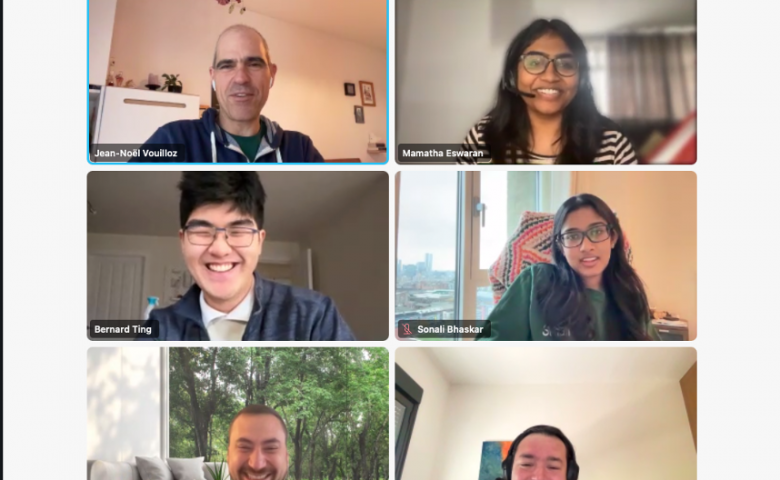
Understanding Business Email Compromise to better protect against it
January 31, 2023
Christa Quarles: How I got here
February 1, 202310 Surprises of Remote Work from Security Engineers

For Cisco engineers working on Duo, having a remote-first workplace has helped them reach life goals, connect with colleagues around the world, and be intentional communicators. We understand that working remotely can be an adjustment — that’s why we’ve compiled the 10 parts of remote work that surprised our team members most and their advice for navigating the nuances. If you’re interested in being part of a remote-first workplace, check out our open positions.
1. More perspectives make a positive impact on the product
Senior Engineering Leader David Rines has worked remotely for the past seven years. He’s found that Cisco’s approach to distributed teams has “enabled us to pick up the right talent, and not necessarily local talent. We are moving towards a global, follow the sun environment,” he said.
One of the aspects Rines appreciates most of this structure is getting “a widely varied set of perspectives and experiences that help build a more reliable, more robust product, which is why we’re here.”

Another benefit to having colleagues across the globe is the sharing of recipes, a perk Senior Site Reliability Engineer Bernard Ting particularly enjoys. Proactively communicating with colleagues virtually “helps you to form bonds with people from other teams. You can always learn something new about cultures elsewhere. I talk to people about food and so I’m always gathering recipes from people from all over the world,” Ting shared.
2. Gathering virtually inspires collaborative problem-solving
While some may fear that working remotely could lead to feelings of isolation and loneliness, a different camaraderie can flourish in the structure of our distributed teams. With colleagues across time zones, “there’s always someone there who you can reach out to help solve your problem,” Rines said.
Collaboration hours are another way Site Reliability Engineering Manager Jaya Sistla has cultivated virtual community and problem-solving. These hours are blocked off for team members to talk about what they’re working on. “The main thing is being able to ask for help so you don’t go into the rabbit hole debugging things,” Sistla said.
Ting points out that working in a distributed model allows you to really engage in virtual events and conversations. Given that the team mainly communicates through online chat, Ting has found that “forces you to see everyone as equally approachable, which has made me more comfortable reaching out to people from anywhere in the world.”
3. Intentional online socializing strengthens teams working remotely
For folks sharing an office, collaboration can happen through casual chats over coffee. When facing a challenge, you can ask your neighbor for support. While ideally virtual communication could have a similar cadence and spontaneity, the logistics of remote and distributed work require intentionality and being proactive in connecting with colleagues as people and as co-workers.
When Ting first started working remotely, he felt that every meeting needed to be formal and have a business objective. By sharing his feelings with his manager, he was reassured that “socializing is a very important part of teamwork, because if you don’t have a good relationship with your colleagues you’re not going to be able to have healthy discussions, healthy conflict or be able to critique each other when the situation arises.”
Since that conversation, Ting has been more proactive about catching up with colleagues, which can include sharing a coffee over video chat. Duo’s “coffee roulette” formalizes the process as every month, employees who opt in can be randomly paired up for a quick half-hour chat focused exclusively on socializing. Ting has found being proactive about socializing virtually helpful. “It’s made me more intentional with my time and really treasure the social experience you can get,” he said.
4. Remote management + training can be effective
Some folks may be concerned that without a manager observing their efforts and work ethic day in and day out, it may be harder to recognize accomplishments and challenges. Ting found that within his team “when you work on projects and in your one-on-ones with your managers, they’re always very intentional about learning what you’ve been doing and seeing what your progress is like on certain projects. I’ve been asked, ‘How do you think you can improve? What are some of the things you’ve been doing outside of the team work?’”

To cultivate cross-team collaboration and education, there are thoughtfully planned virtual lunch and learns. “We schedule training sessions and common meetings at times that are flexible for everyone. If it has to be repeated, we do it so people can comfortably attend rather than stretching themselves and attending at odd hours,” Sistla said.
5. Informal communication = hugely important [bonus points for individualized emojis]
For Software Engineer Nick Aspinall, an important and fun part of working remotely is keeping in touch with virtual messaging. One unique perk has been getting to create and customize emojis with team members including a few of himself in “various ridiculous states,” he said.
Connecting with colleagues on themed channels focused on personal and professional interests from coffee to pets “makes it really cool because you can meet people across different teams and still get some of the feeling of rubbing elbows that you get when you’re in the office,” Aspinall said. Participating in these virtual conversations boosts morale while also providing an endless supply of cute animal pics.
6. Conveying different information requires different formats
Given the multi-faceted nature of our work and the importance of consistent information sharing, having different communication channels and formats to communicate data with varying degrees of complexity is vital. Having information readily accessible, accurate and updated is particularly necessary in a field like cybersecurity.
Senior Software Engineer Mario Lopez finds that the variety of information sources contributes to an easeful remote working experience. For instance, for complex architecture decisions or detailing, Duo’s Wiki is the best source.
Software Engineer Hanna Fernandez has benefited from chat channels dedicated to design and engineering topics to “see what everyone’s up to and what thoughts people have,” she said. Sista pointed out these are great places to ask questions and open up dialogue to solve problems.
7. Video-on culture increases empathy and smiles
Our culture is “video-on,” meaning that it is preferred that during video meetings, as much as possible, attendees have their cameras on. Lopez loves this because “you get a bit of that personal human element.”
“We’re all people behind these screens. You definitely get some of people’s personality through text, but you get it more when you actually see them. It’s infectious when you see someone smiling. You’ve got to smile back,” he shared (while we both smiled).
8. Small talk matters
When Fernandez started at Cisco, she was advised to schedule individual meetings with everyone she would be working with on every team that she joined. That suggestion is one she’s applied even virtually.

“It’s a great strategy because I already know that my team is super talented and very smart, but this way I also get to know them as humans beyond their roles,” Fernandez said. Fernandez also finds it important to check in with co-workers and ask how they’re feeling and how their time off was. “I know a lot of people hate small talk, but it’s not just small talk. I’m genuinely interested in how my co-workers are doing.”
9. Life goals can more easily become reality
One of Ting’s biggest goals was buying his first house in the countryside outside of London. By working remotely, Ting has flexibility in his location which allowed him to achieve his goal of buying a house and settling down with his partner, while giving their dogs the space they need to be dogs.

10. Take time to transition as an engineer working remotely
When transitioning from fully remote to hybrid, it’s important to recognize that there will be some shifts to get accustomed to. As the structures of remote, distributed and hybrid work evolve, it’s important to stay flexible and notice what’s possible through multiple modalities of team building. Many teams have enjoyed in-person gatherings and connecting through virtual lunches and team games when remote.
Fernandez has had multiple roles with multiple structures at Cisco. As an intern, she was fully in person and shared desk space with other interns who collaborated on full stack engineering. While working in finance IT, Fernandez was hybrid and many of her colleagues were distributed among multiple offices. The pandemic began while she was in a DevOps role, forcing her to maintain boundaries around her work time while working fully remotely. In her current role working on Duo, Fernandez is completely remote but advocates for in-person events if possible, because “humans are social creatures who want to see each other’s faces in real life once in a while.”
For Aspinall, “when we did come back to the office, there was a bit of an adjustment period where you were overstimulated from the office.” He also wanted to ensure team members who were 100% remote were fully included. Now he sees that while half his team is fully remote and the other half is hybrid, “that doesn’t stop anyone from doing anything. All of our meetings feel the same. They’re all seamless.”
If you’re interested in joining our team from wherever you are in the world, check out our open roles.
We’d love to hear what you think. Ask a Question, Comment Below, and Stay Connected with Cisco Secure on social!
Cisco Secure Social Channels


